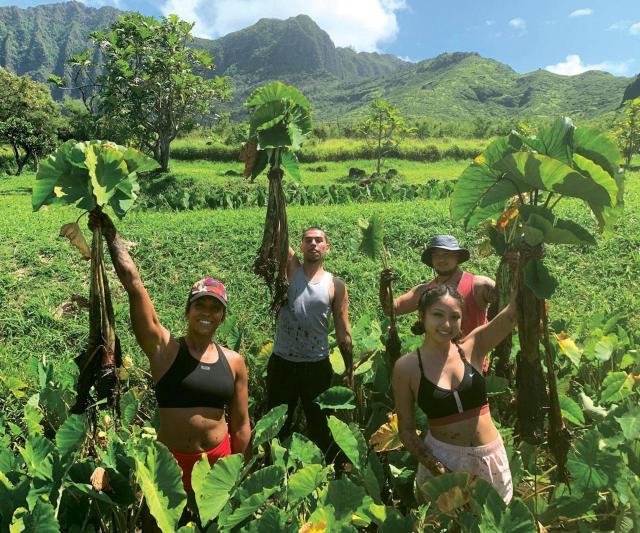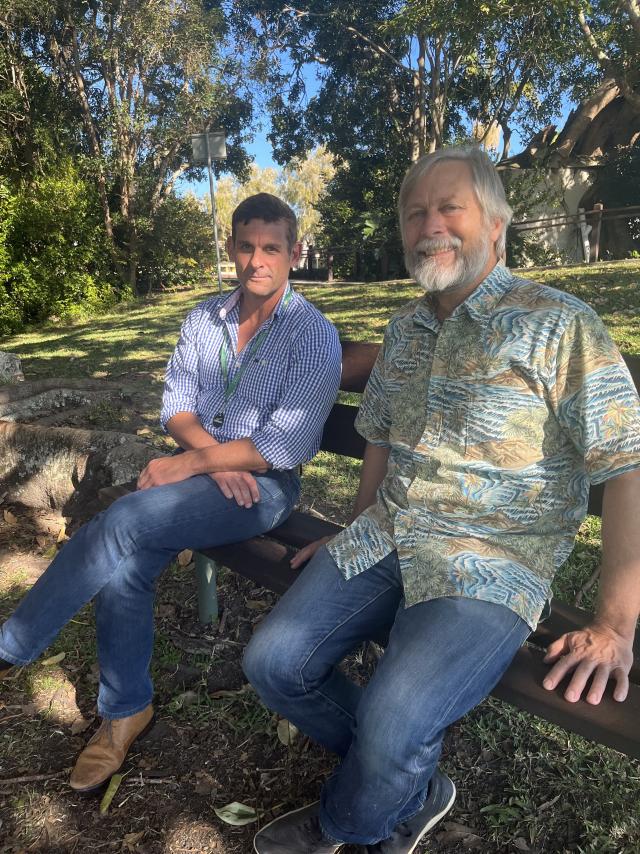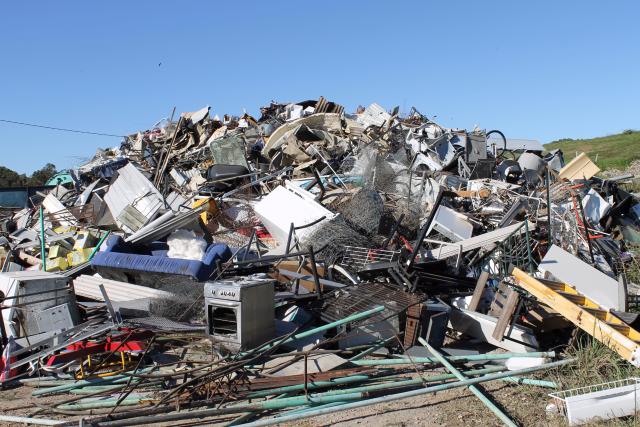Kyrone Dodd looks up at 30 metres of landfill waste and fears for a future when this could well be a mountain more than twice as high, visible from as far away as our beaches.
Tom Wegener conjures up an ancient Hawaiian mountain of rock-walled food gardens cascading down to fish ponds where freshwater streams meet the sea, capable of feeding the entire pre-contact native population.
Noosa Council’s waste manager and the councillor and sustainable wood surfboards guru are visualising two extremes of a future dependent on how we act now to control waste. I don’t think Kyrone really believes that a skyscraper of rubbish will dominate the Noosa skyline in 10 or 20 years’ time, nor do I believe that Tom thinks that in our hinterland hills we could replicate all of a sophisticated land-management and food-production system that once allowed Hawaii’s isolated and densely populated pre-contact communities to be entirely self-sufficient. But dreams (and nightmares) are free, and when you’re dealing with complex community problems that require immediate solutions while many residents don’t even recognise that the problem exists, well, it’s good to have a vision.
And, as unlikely as it seems, there are elements of the ancient Hawaiian system that could be employed locally. Before the arrival of James Cook in 1777, the Hawaiian chiefs distributed land in long strips called “ahupuaʻa”, described as extending from “mauka” (mountains) to “makai” (ocean), with each ahupua’a having its narrow starting point high in the inland volcanic peaks, and then widening, like a slice of pie, to include a stretch of shore and fishing grounds up to a mile out to sea. Channels diverted stream water to circulate water from pond to pond and prevent stagnation. The result: per-acre yields five times that of dry-land farming. There were thousands of these across the island chain, each with individual characteristics based on elevation and availability of direct sun, but overall, the enormous variety of crops up and down the ahupuaʻa provided a varied diet and served as a hedge against the failure of any one crop.
Says Tom Wegener: “I look at these huge mounds of what we used to call green waste, but should really be called green resources, and I think of all the hobby farmers out there who could use the double grind produced from it to make their land regenerative. I think back to ancient Hawaii where they had a system in which the top of the mountain was rainforest where you could down a tree or two for canoes and other necessities, mid-mountain was for animal life, and at the bottom was land for farming. Below that were fish farms in the waterways. It was a very interactive system and there are many parts of our shire where you could do that now to create market gardens of regenerated soil. And if it was done the right way you could also reduce the levels of silt going into the river. What I’m seeing is more or less an extension of the Keep It In Kin Kin campaign. To make it happen we need 20 clones of Noosa Landcare’s Phil Moran.”
Cr Wegener continues: “The waste survey came back with the overwhelming view of residents that they want to recycle green waste within Noosa, not have it buried in landfill. Our surveys also suggest that Noosa is actually pretty good at separating waste, and of course council has been sending out these messages for a long time now, thanks to Cr Joe Jurisevic’s commitment to the cause, and waste is one issue all councillors agree on. But the part that hasn’t sunk in is what we have to do to ensure that a large part of our waste can end up in people’s food gardens. That’s the messaging now, and it’s worked in other countries so it will work here.
“I think Cooroy Community Garden has already shown in a small way how green resources can be used with coffee grinds to create great compost with the right balance of microbes, and a biproduct of that in many instances is a reduction of silt in the river. That’s the big picture vision. A regenerative small farm culture using our mountains of green resources to create the best produce.”
Waste manager Kyrone Dodd tells Noosa Today: “It’s more than just a vision because we’ve actually done a lot towards building a circular economy. For the past two years we’ve been looking at local use of our mulch and that’s been taken up by local macadamia farmers who are seeing huge benefits from using it instead of petrochemical fertilizers, and they’re now taking huge amounts from us. We’ve moved around 10-12,000 tonnes this past financial year to one farmer in Cootharaba alone. We need the big guys to continue to use that much and the hobby farmers to take up the rest. And the cost comparison is extremely good too. Instead of paying $100 a tonne for fertilizer they’re paying $10 for our mulch. There’s a bit more work in spreading it. but the long-term benefits are great.”
Project officer Jo Ferris points to similar advances being made in polystyrene recycling: “It’s to the point where we’ve had to buy a bigger compaction machine to do it. The idea behind that is to create a higher quality recycled product, at which point we need businesses to complete the circle, and that’s happening too.”
Getting waste from the resource recovery centre into industry can be made easier through the use of online marketplaces like the Advisory System for Processing, Innovation and Resource Exchange (ASPIRE). Says waste education and sustainability manager Peita Otterbach: “The council has an annual membership with ASPIRE which means that they look at our waste production and put a value on it, then advertise it on their website portal to find buyers. For example, the RACV resort had a huge amount of artificial turf which we were able to sell through ASPIRE and quantify the carbon emission savings of that transaction. There’s another local business with a huge number of timber trusses who are doing the same thing. Then you have the Heads of Noosa brewery who are big in this space too. Their malt waste goes to pig and cattle farmers for feed.”
Kyrone Dodd adds: “98 per cent of the waste concrete that comes in is now sold or we use it within our own construction teams. There is so much construction work and infrastructure building going on in Noosa that we have had to focus on recycling the materials we use, which we’re now doing to between 50 and 60 per cent.”
So no one is sitting around dreaming about what might be. The council waste team is hands on and dedicated to achieving results, but there is a lot of work to be done so those hands are usually full. Says Kyrone: “Our goal is to eradicate food waste from our landfill. There are several different technologies you can use to do that, but in-vessel composting and anaerobic digestion are the primary ones. Council is conducting feasibility studies on building them in Noosa. A lot of this is also dependent on working with other councils for reasons of volume, as in our recent memorandum of understanding with Gympie Council. A lot of this will come out when we finish the Waste Strategy, but the issue is not so much affordability as feasibility. For example, while volume is important to the cost structure, one food waste facility for SEQ somewhere south of Brisbane doesn’t make sense for Noosa because of the costs and carbon emissions of moving it. At some point landfill becomes the most expensive option, and that’s when we start to see real results.”
That point is now, with the landfill levy increased substantially since 1 July, with impacts on both industry and residents, and the prospect of it continuing to ramp up in 10 per cent increments over the next five years. But when it comes to waste generally, there’s another elephant in the room besides the prospect of waste skyscrapers dominating the skyline. It’s called tourism.
Says Kyrone: “When you add 1.8 million tourists a year to the equation, people who come from all parts of the world and potentially have no idea of how our waste system operates, where you put this or that, you have a whole other set of behaviour that is very difficult to change in the course of a two-week holiday. Reaching the tourists is a project in itself. You can’t blame them for it, but the reality is they buy a lot of takeaway food in one-use containers and don’t know how to dispose of it.”
Kyrone concludes: “One of the most disheartening things for me is looking at what we throw away on landfill, so much stuff that shouldn’t be there. That’s one of the major planks of the community feedback – taking greater personal responsibility. It has to be there if we’re going to have change. We can’t be throwing away shirts that we’ve worn twice, for example. Over a generation or two we’ve lost the art of repairing rather than replacing. We need to get it back.”











